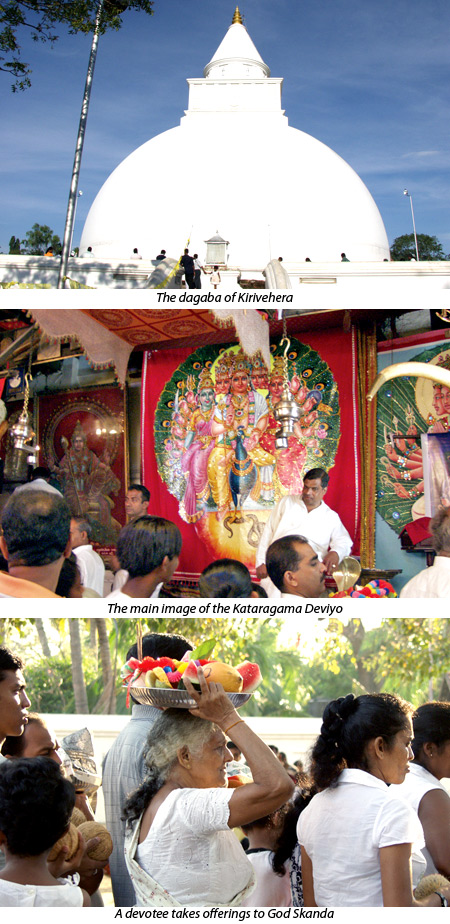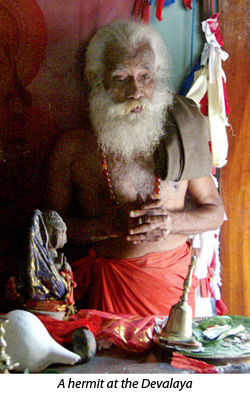Pageantry, ceremony and ritual are part of everyday life in Sri Lanka. No matter where you travel to in any part of the country or when, you are bound to be caught up in some form of national festival.
 However, if you travel down South in August, you will be fortunate to witness the country’s most spectacular pageant: the Kataragama Esala festival which began on July 29. This pays homage to God Skanda and the Esala Full Moon Poya.
However, if you travel down South in August, you will be fortunate to witness the country’s most spectacular pageant: the Kataragama Esala festival which began on July 29. This pays homage to God Skanda and the Esala Full Moon Poya.
Kataragama is a uniquely holy city. When I was a schoolboy in the late 70s, my uncle had a van, which was actually a Bedford car bearing an ‘EN’ number converted into a van with a wooden structure in the rear. He used to take us all on an annual pilgrimage to Kataragama in his van.
Journey to Kataragama
We took the most adventurous coastal route along Galle Road (there was no expressway then). Our first stop was at the Kalutara Bodhi tree where an offering and a plea would be made for our safe return. Some pilgrims also stop at prominent religious places, such as Mulkirigala, Devinuwara and Tissamaharama. Here too we would appeal for a safe journey to and from Kataragama. We took two days to reach Kataragama.
Today, travel times have been reduced. The trip to Kataragama takes only a few hours from Colombo. Those taking the Southern Expressway would take a very short time.
As soon as we arrived at the Kataragama sacred city, we looked for a resting place to stay overnight. There were plenty of rest halls around Kataragama. Our next task was a dip in the Menik Ganga, the Holy River to cleanse ourselves. Often, the water is only knee deep or even less. Following the bath, we changed into white clothes, which is considered a sign of purity.
Shops outside the Devale premises offer a range of Pooja Bhanda (articles for offerings), in particular, an assortment of fruits commonly used for the purpose. Prices differ according to the size of the basket of offerings selected. A common item seen on all was a garland of red flowers made out of polythene. Thus, carrying the offerings, we crossed the river through the narrow bridge and walked to the Maha Devale, the main shrine.
Chanting Haro Hara, Haro Hara, Hindu devotees in their hundreds throng the precincts of the Kataragama Devale, an abode dedicated to God Skanda, also known as Murugan among the Hindu devotees and Kataragama Deviyo among the Buddhists in the deep South. Buddhist pilgrims flock to the sacred site where a Bo tree and a temple exist alongside the Devale. Muslims too have a mosque attracting devotees.
The sanctuary nestles on the bank of the Menik Ganga, (River of Gems), the holy river of thousands and thousands of devotees in Sri Lanka. Around four kilometres South of the holy shrine rise the seven hills of Kataragama known as Vedihiti Kanda. The holy peak of Kataragama is believed to be the adobe of the Kataragama Deviyo (Deity).
Until recently, Kataragama was a jungle village with a dirty track leading from the town of Tissamaharama, 19 kilometres away. Kataragama’s metamorphosis came with the construction of a motorable road and the introduction of electricity and a steady supply of water to the area to coincide with a Gam Udawa (Village Reawakening) project launched in the area during the reign of the late President Ranasinghe Premadasa in the late 80s. It is now a bustling town, teeming with pilgrims and hordes of vendors with their colourful wares. There are a number of luxurious star class hotels and rest houses for the weary travellers.
Beside the Maha Devale, dedicated to the Kataragama Deviyo, there are other devales dedicated to Valliamma, Thevaniamma, God Ganesha and other minor deities. Close to the Devale lies the majestic Buddhist dagoba named Kirivehera built by King Mahanaga in 104 B.C.
The Kataragama Deviyo, whose blessings Hindus, Buddhists and others invoke for success in worldly affairs, in relieving distress and healing diseases, has several names. The most popular is Kataragama Deviyo. The Tamils call him Kandaswamy. Others call him Skanda. Dr. Ananda Coomaraswamy identified him with Kartikaya, the God of War in Hindu mythology. He is also known as Kanda Kumara. He is depicted as having six heads and 12 hands and feet, and is believed to be riding on a peacock.
Tradition has it that he married Devasena, a daughter of God Indra who, according to Hindu mythology, rules over three hundred and thirty million lesser gods. Another tradition says, he has two other wives, Thevaniamma and Valliamma. The story of how he wooed and won the heart of the latter is interesting. Valliamma was the beautiful daughter of a Veddha chief and used to watch her father’s crops. One day, the Kataragama Deviyo happened to see her and was enamoured by her.
Frightening trick
He at once wooed her, but all his entreaties could not melt her heart. So he sought the assistance of his brother Ganesha, the God of Wisdom, to win her. The two brothers decided to play a frightening trick on her.
 Accordingly, one day, the Kataragama Deviyo began to woo her when she was watching her father’s plantation. Assuming the guise of an elephant, Ganesha appeared on the scene and trumpeted aloud. The trick worked like magic.
Accordingly, one day, the Kataragama Deviyo began to woo her when she was watching her father’s plantation. Assuming the guise of an elephant, Ganesha appeared on the scene and trumpeted aloud. The trick worked like magic.
The unapproachable Valliamma at once clung to the Kataragama Deviyo for protection and promised to yield herself to him if he would save her from the elephant.
According to the plan of the two brothers, the Kataragama Deviyo was to will that Ganesha’s elephant guise should vanish the moment Valliamma was won. But the Kataragama Deviyo forgot all about his part of the arrangement owing to the ecstasy of the moment and Ganesha is supposed to carry an elephant’s head on his shoulders to this day. Legend says that King Dutugemunu, the national hero who unified the country was the first patron of Kataragama. He is said to have made a vow to construct a shrine in honour of Skanda if he was victorious in the war against the invaders from South India. The shrine thus dates back to the 2nd Century BC.
Today, leaving aside their religious differences, Hindu, Buddhist, Muslim and Christian devotees linger freely in the Kataragama Devale premises, showing much camaraderie.
They carry the Pooja-vatti to God Skanda which are handed over to a Kapurala coming through a long queue around the Devale premises. The Kapurala who accepts the offerings would place a little holy ash on the forehead of the devotee. A part of the offering is kept back and the balance returned in the form of holy food.
Symbol of gratitude
Dashing coconut is a common happening at Kataragama and is considered an act of homage to the gods or a symbol of gratitude. It is also one of the simplest ways of settling a vow. Vows are made at Kataragama to fulfil a longing or need in life, to seek redress from a problem or cure for an illness.
Some devotees in the way of penance resort to extreme physical pain to invoke the god’s favour. Some devotees have quite a large number of hooks driven through the bare flesh of their shoulders. The most amazing feat is the walking on live red-hot embers on bare feet. Strangely, these fire-walkers come out of their feat unscathed.
The centuries-old annual pilgrim walk Pada Yatra from the Northern Jaffna peninsula, down the East coast and through the jungles of the Kumana Yala East National Park to Kataragama takes place with Hindu devotees gathering at the Murugan Devale at Okanda.
Thousands of devotees are expected to take part in this spiritual walk, which starts at the beginning of June and lasts about 45 days.
The trek through the Kumana and Yala National Park for pilgrims will be open for one week.
